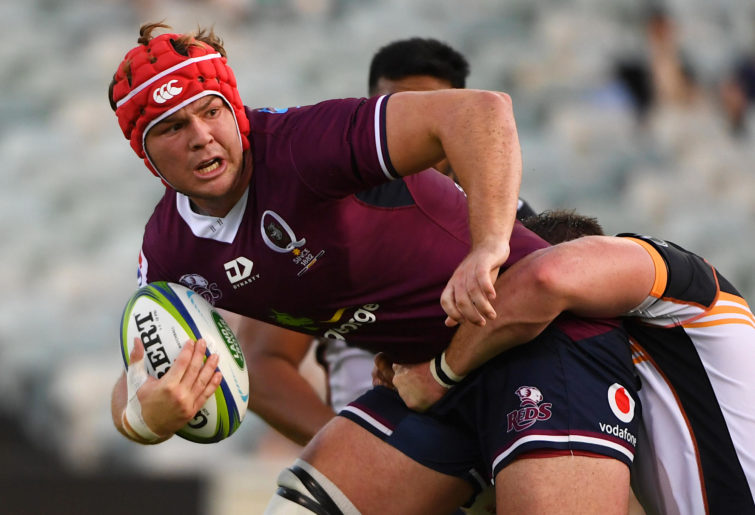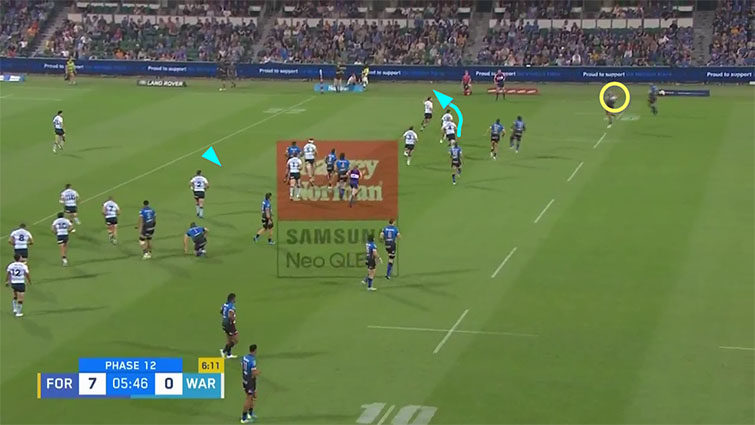Thanks once again to all who either contributed a question, or debated one in this week’s callout. Watching a query as it is refined through discussion can be especially helpful to my responses on Friday.
Is it just me or does it appear that our most consistent forwards in terms of total contribution are weighted to Force, Rebels and Brumbies? Waratahs and Reds both seem a bit short of impact?
– Noodles
Statistically, who are the most effective loose forwards in Super Rugby AU and Super Rugby Aotearoa?
– KiwiHaydn
What do you think of the role of playing flankers or number eight in the second row? Last week Rob Leota, Angus Scott-Young and Hugh Sinclair were all in the second row. These players are generally around 190cms. Do you see this working in international rugby?
– Take the Points
These questions are all related to one another, directly or indirectly. As the game gets faster and the ball-in-play time increases, one of the spots coaches tend to look at for an increase in overall team speed is the second row. There has been something of a boom in players who can operate equally effectively in the last two rows of the scrum.
Some of the best big men in the UK and Ireland can handle both number six and second row efficiently – Maro Itoje and Courtney Lawes in England, Tadhg Beirne and Iain Henderson in Ireland, Bernard le Roux in France. Even Alun-Wyn Jones started out as a blindside flanker before deciding his best position was going to be one row ahead in the pros.
If all five of those players were fully fit, they would be on the plane to South Africa with the Lions in a couple of months. There, they will lock horns with the best of breed on the planet in the shape of Pieter-Steph du Toit. In order for these players to succeed at Test level, as a general rule they have to be 195 centimetres plus.
The meat of the question is a comparison of the productivity of the loose forwards in Super Rugby. I’ll leave Super Rugby Aotearoa to a separate column and focus instead on AU.
Here is a table containing the stats for the top loose forwards in Australia. I’ve used 450 minutes of play as the baseline for inclusion. There are also two forwards – Tim Anstee and Lachie Swinton – who have not racked up the minutes, but are clearly players of national interest.
First, the attacking stats.
| Minutes between carries | + or – impacts | Decisive outcomes (breaks or try assists) | Lineouts won | |
|---|---|---|---|---|
| Harry Wilson | 7.1 | +3 | 0 | 5 |
| Pete Samu | 14.7 | +3 | 8 | 9* |
| Brynard Stander | 8.3 | +8 | 1 | 4 |
| Michael Wells | 14.2 | +9 | 4 | 17 |
| Angus Scott-Young | 11.5 | +3 | 0 | 17 |
| Rob Valetini | 10.3 | +11 | 4 | 2 |
| Tim Anstee | 8.2 | +2 | 5 | 16 |
| Lachie Swinton | 8.6 | +5 | 0 | 14 |
| Josh Kemeny | 10.5 | +8 | 1 | 5 |
| Fraser McReight | 9.8 | +14 | 10 | 1 |
| Kane Koteka | 12.1 | +12 | 3 | 1 |
| Richard Hardwick | 14.5 | +3 | 3 | 0 |
| Carlo Tizzano | 9.2 | +7 | 2 | 0 |
*includes steal
‘Minutes between carries’ is a guide to work-rate on attack, while the ‘Impacts’ (gain-line wins) and ‘Decisive outcomes’ columns are measures of success. Lineout is obviously another key stat for the bigger men at numbers six and eight.
Harry Wilson has a huge work rate (more than twice the frequency of carries compared to Pete Samu, for example), but he has really struggled to make an impact in 2021.
Wilson and Samu offer two contrasting interpretations of the number eight’s role: Wilson an inside power runner and ground-gainer, Samu operating in the wide channels as a strike runner and game-breaker.
Rob Valetini is by far the most dominant number six on the gain-line, while Tim Anstee holds out the promise of being able to fill the Samu-type role at lineout and wider out in attack.
Fraser McReight is obviously the outstanding number seven playing in Australia, and the relative lack of success of Wilson and Angus Scott-Young on the gain-line at the Reds has not inhibited his orbit of influence as an attacker.
Here are the stats for defence.
| Mins between tackles | Tackle completion | Discipline/turnovers (inc. pens conceded) | |
|---|---|---|---|
| Harry Wilson | 7.2 | 88% | -9 |
| Pete Samu | 9.3 | 87% | -6 |
| Brynard Stander | 7.2 | 81% | -2 |
| Michael Wells | 9.6 | 92% | -10 |
| Angus Scott-Young | 6.9 | 91% | -9 |
| Rob Valetini | 7.8 | 92% | -3 |
| Tim Anstee | 6.3 | 89% | -3 |
| Lachie Swinton | 4.9 | 88% | -8 |
| Josh Kemeny | 6.9 | 96% | -5 |
| Fraser McReight | 6.6 | 94% | -2 |
| Kane Koteka | 5.6 | 86% | -9 |
| Richard Hardwick | 8.4 | 83% | 0 |
| Carlo Tizzano | 4.1 | 90% | -7 |
‘Minutes between tackles’ is used to represent work rate on defence, while the ‘Discipline/turnovers’ column weighs turnovers won against those given up and the penalties conceded by the same player. A figure close to zero is an excellent outcome.
The immense tackle work rates for both Swinton and Carlo Tizzano (both sub-five-minute tackle intervals) illustrate how little possession the Waratahs were able to win and maintain this season. Swinton’s discipline and his defence of the ball on the carry remains a concern, as his minus-eight was derived from only 350 minutes of play.
McReight’s numbers are just as outstanding on defence as they are in attack. He made 11 turnovers while only giving up six penalties at the defensive breakdown, and maintaining a tackle percentage in the mid-90s.
The number of involvements by Harry Wilson is again very impressive, but there is the same lack of impact or quality. There is a sense Wilson is undergoing a plateau in his pro career, and urgently needs the support of another number eight of a similar type – like Isi Naisarani – in the Wallabies.

Harry Wilson. (Photo by Tracey Nearmy/Getty Images)
Watching the Waratahs’ centre pairing over the past few weeks has been at least one bright spot for the team. How do we unlock their potential better? Do you see any Wallabies game time for Izaia Perese or Lalakai Foketi?
– Stin
After a false start, Izaia Perese has arguably been the Tahs’ best attacker and he appears strong on defence, but is his defensive positioning good enough to make him a Wallabies contender?
– Hazel Nutt
Will Izaia Perese be the only backline representative from New South Wales in Dave Rennie’s match-day squad? I’m thinking Perese may get some time, he breaks nearly every tackle one on one and can also play on the wing.
– Take the Points
There does seem to be a difference in the quality of Perese’s involvements on attack and in defence. He can be a lethal offloader in the wide channels:
Two different types of offload executed perfectly – right-arm underhand to Mark Nawaqanitawase in the first example, out of the back of the hand to Jack Maddocks in the second. Perese ensures that the last defender is committed before delivering the pass.
So far, so good.
Things did not look as proficient on defence against the Force, however.
In the first example, the Waratahs have the numbers out wide, but Perese loses Tevita Kuridrani to a simple cut off his right foot – he has to remain connected to the forward inside and protect him. Later in the same sequence, his side of the defence was again beaten on equal numbers.
Perese’s tendency to sit off and let play develop in front of him creates a lot of difficulties for the men around him:

That means a lot of work for the defence coach Matt Taylor if Perese gets the call to Camp Wallabies.

Izaia Perese. (Photo by Jono Searle/Getty Images)
Some tighthead props bind low on the hooker’s shorts instead of up across the shoulder. Physics of this bind angles his body inwards and thereby concentrating the drive energy towards the hooker. Why do they do this? Is it to concentrate more energy on the hooker and force the scrum inwards or, is it a counter move to stop the hooker coming through that space?
– Wayne
If you watch the front rows set up for a scrum, you’ll notice the loosehead and hooker binding up tight first, in the region between chest and shoulders. The better tightheads will enter as the last man and look to bind as low on their hooker’s shorts as possible with their left arm.
Why? Because it gives them maximum flexibility in the shoulders to change their angle of attack in the gap. The tighthead is scrumming against two opponents (the opposition hooker and loosehead), so he needs the flexibility to be able to counter that pressure on his own terms.

The low bind allows Cabous Eloff to drop inside and follow Jordan Uelese through the middle of the Waratahs scrum to win a game-clinching penalty. Eloff is, incidentally, a prop well worth a look from the Wallabies coaches as a support tighthead in 2021.
Who should be the halves pairing for the Lions?
– Tim Westphal
With most head contact in a tackle now leading to a sending-off, is it worth going for a dominant chest tackle when the slightest miscalculation or accident can see these shots hitting the ball carrier high?
– tighthead
May I throw Owen Farrell’s name into the mix?
– Just Nuisance
Folks, it’s Lions watch time again! Warren Gatland has always tended to prefer a solid tactical navigator and a big defensive number ten in his teams, so my guess that the likes of Owen Farrell, Dan Biggar and even Johnny Sexton will be preferred to Finn Russell and George Ford.
One of the reasons you need a strong high tackler there is South Africa will pick a giant inside centre to run straight down that channel – a Damian de Allende (1.91m and 105 kilos) or an André Esterhuizen (even bigger at 1.94m and 115 kilos).
If you cannot stop de Allende and Esterhuizen or prevent them from passing through contact, it is unlikely you will be able to stop the Bokke power game. This presents some problems with the current refereeing sensitivity to shots at shoulder height.
Remember what happened the last time ‘Faz’ and Esterhuizen clashed in an England versus South Africa game?
At the time (November 2018), this tackle did not even incur a penalty. In the current climate, it would definitely be worthy of a card – the only question would be the colour. Warren Gatland is sitting on the horns of a dilemma.
Thanks to all of those who contributed once again, unanswered questions will be stored for future issues.
Original source: https://www.theroar.com.au/2021/04/30/coachs-corner-issue-10-how-loose-can-you-be/
source https://therugbystore.com.au/coachs-corner-issue-10-how-loose-can-you-be/
No comments:
Post a Comment